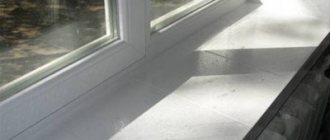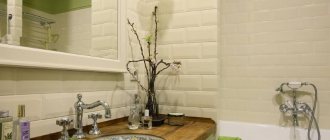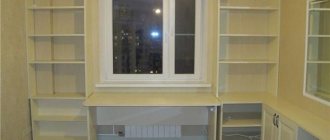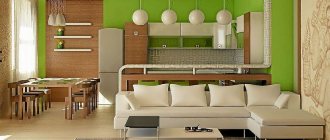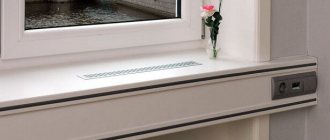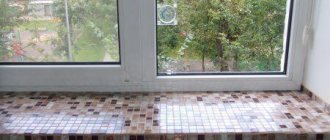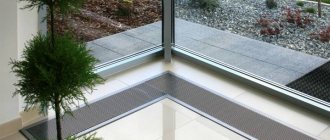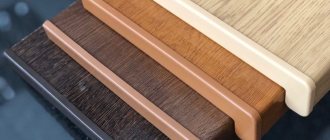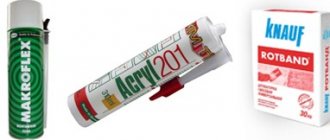Usually people think about window sills at the last stage of renovation work. The only exceptions are those window sill representatives that either transform into a bench or are combined with a worktop in the kitchen. Otherwise, no one really thinks about this part of the window system until the last minute. We decided to correct this state of affairs - to figure out which material is more profitable and which window sills are best to choose for an apartment, and what to install in a country house.
Meanwhile, manufacturers of window systems recommend taking the choice of this attribute seriously, because poor-quality installation or an unsuitable model ultimately leads to its premature replacement. By the way, replacing the window sill after installing the window unit is technically difficult and expensive.
What are the requirements for window sills?
In addition to the aesthetic side, the slab under the window performs important functions. When installed correctly, it prevents heat from leaking from the radiator to the outside, traps cold air from the street, and creates air flow circulation in the room.
There are no strict rules for installing a window sill, but when making calculations it is worth taking into account some nuances. In order not to disturb the circulation of warm air in the room, the window sill should not protrude more than 5-6 cm from the plane of the wall - this means the finishing. If, according to the designer’s idea, the slab should be wider, then additional ventilation holes will be needed.
The optimal thickness is the average standard, approximately 2-4 cm. A sheet that is too thin will sag, which will eventually break the joints. And a very fat person risks looking heavy and rude. Another important factor is the bending strength of the window sill, since it is mounted into the wall and the entire structure must remain motionless. The slab must be as hard as possible, because people will lean on it with their hands, sit down, put some things on it - due to incorrect calculations, the structure may not withstand the load and break.
Basic requirements for a window sill:
- Strength and wear resistance;
- Duration of service life;
- Low requirement for special care;
- Constancy of appearance under the influence of ultraviolet radiation;
- Harmless to health;
- Stylistic compatibility with design.
Installation Features
When you no longer need to think about how to choose a suitable plastic window sill, you select a stand profile (a plastic pipe with a rectangular or square cross-section). It serves as the basis for the entire window structure (window sill, drain and frame), therefore it is mounted under the double-glazed window frame, to which the external ebb and flow with the internal window sill are fixed. You can also place the window in a special groove, leveling it with wooden blocks. A plastic board is often placed in a horizontal plane, but sometimes with a slight slope into the room (for every 30 centimeters of board width there is a 3 cm slope).
The service life of the structure depends on the correct installation of the window sill system.
The profile is fixed with high frost-resistant polyurethane foam with a low expansion coefficient. The entire interior space should be treated with foam, after which a heavy object (a bucket of water, books) is placed on the board so that when the foam hardens, the window sill does not rise.
Installation diagram of a plastic window sill
The correct selection and installation of plastic products will ensure high window performance.
What materials are used to make window sills
The choice of window sill is influenced by the customer’s preferences, possible design features and conditions, and the planned budget.
It is impossible to say unequivocally which window sill is better - glossy or matte, because both textures have their advantages and disadvantages.
Comparative characteristics of the two textures, placed in the table for clarity:
| Glossy | Matte | |
| Resistance to damage | The slightest scratch is visible | Scratches are not visible |
| Surface care | Simply wipe with a wet cloth | Need cleaning supplies |
| Appearance | Any contamination is immediately noticeable | Dust is almost invisible |
| Texture | Reflects light well, increases illumination | Suitable for a room where the light needs to be dimmed |
There are a huge number of types of raw materials for the production of window sill slabs. There are not quite standard ones: decoration using porcelain stoneware, mosaics, even fabric upholstery.
The design of window sills, their shape, and dimensions primarily depend on the material from which they are made.
The most popular models:
- Plastic (PVC - polyvinyl chloride);
- Tree; Chipboard, MDF and WPC;
- Natural or artificial stone*.
Let's talk in detail about each of these options separately.
Application of laminated overlays
Laminated PVC window sills can be manufactured in factories and presented to buyers in finished form, but for the restoration of old products there is an interesting technology that allows you to change their appearance without dismantling the structure.
You can laminate the window sill yourself by purchasing special overlays for this and following certain steps. The main feature of the PVC lining is its ability to completely change the appearance of the window sill, correct damage noticeable on it, change the appearance of the structure without requiring it to be dismantled. This significantly reduces the time spent on updating the interior and the cost of work. The overlay also serves as a kind of protection that prevents the main structure from collapsing or receiving significant damage, for example, during repairs, when any objects may fall on the window sill.
The PVC window sill cover can have different colors, the structure of the material is also different, it can, for example, imitate wood. Overlays are available in standard sizes - 1.5 meters deep and 3 meters wide. If necessary, you can cut the product to the desired length using a grinder or a metal file. The material can be easily sawed by hand. You can hide the side part using end caps. Thanks to this, the product will have a monolithic appearance, an attractive appearance without seams or noticeable joints.
Window sills laminated with Renolit film
Plastic (PVC) window sill
PVC (polyvinyl chloride) is the most common type. What window sills are best to buy for plastic windows? Manufacturers of metal-plastic systems themselves answer this question when they propose installing a plastic window sill along with the window. This is reasonable and justified, because all the technical characteristics of the window system will be the same and will last the same long time. Externally, this will also look harmonious: PVC has no color restrictions, because the film with which the slabs are covered can have any shade and imitate any texture.
PVC, due to its moisture resistance and thermal conductivity, is excellent for the production of window sill slabs. However, plastic window sills are hollow, their strength depends on the number of stiffeners in the structure. The heavier the slab, the more ribs it has, the thicker they are, the more reliable and stronger the window sill will be.
Due to sensitivity to heat, the plastic sheet must be placed at a distance from the radiator no closer than 15 cm from the hot air, otherwise it may bend. Due to thermal conductivity, PVC has a high coefficient of thermal expansion, which means that cracks can form at the joints. To avoid this, it is necessary to use the most elastic sealants (silicone) to process all seams. To increase service life, all joints must be renewed every two years.
How does plastic meet the basic requirements for window sills, which we have already discussed? For clarity, we have collected the data in a table.
| Requirements | Compliant | Does not match |
| Strength, wear resistance | Depends on the stiffeners | Scratches, cracks, chips may appear |
| Life time | 30-50 years | |
| Special care | Moisture resistant. Just keep things in order | The matte surface gradually “absorbs” dust and dirt |
| Effect of ultraviolet | High-quality plastic does not change its appearance. | May turn yellow |
| Environmental friendliness | It is not subject to rotting, which means that bacteria and microorganisms do not develop on the surface. Does not emit harmful substances | |
| Stylistics and aesthetics | Large selection of shades |
What is required to fix the pad?
Repair pads for PVC window sills are fixed to the surface of the product as follows:
- The back side of the pad is cleaned, removing dust and debris.
- After this, glue is applied in a zigzag pattern to the underside of the lining.
- The trim is pressed against the window sill, pressed down, and traces of excess glue are wiped off with a wet rag.
- The end caps are secured using transparent silicone.
Repair of plastic window sills ends with sealing the joint between the window sill and the window frame. If this is not done, moisture will get into the cavity, dirt may accumulate, and mold will form over time.
You can close the joint by filling it with sealant or using corners and a special rubberized profile.
Wooden window sill: pros and cons
In industry, different types of wood are used to make window sills, which can differ significantly in their properties. For example, the price of coniferous trees will be low. The pattern of such wood is beautiful, but the structure is too soft, highly susceptible to humidity and temperature changes. The exception is larch: high strength, almost like oak, and a square meter will cost about 2,600 rubles. This is the answer to a common question: where to order a window sill at an affordable price and, at the same time, of good quality - order a larch slab.
Deciduous wood is much stronger than coniferous wood, so prices will be much higher - from 4,000 rubles/m². Rare species (red, black, sandalwood) are a premium level and any furniture made from such wood is made only to order.
But there is an alternative to solid wood - laminated wood slabs. Under high pressure (and high temperature), thin slices of wood are glued together. The resulting shields are no worse in quality than solid shields, and are even less susceptible to deformation.
The main disadvantage of wood is its sensitivity to moisture. When the window slab swells, it becomes deformed and the seams gradually lose their seal. This is especially true in kitchens, where there is more condensation than in other rooms. To solve the issue of condensation, it is necessary to establish the circulation of warm air in the window niche.
The thickness of the wooden board, glued or solid, must be at least 30 mm. It is impregnated with antiseptic and protective agents. To do this, choose any: varnish, azure, oil, wax. Approximately every 2 years, the protection needs to be updated - first the surface is cleaned with sandpaper, and then the entire course is repeated from impregnation to the final protective layer.
Compliance table with requirements:
| Requirements | Compliant | Does not match |
| Strength, wear resistance | Withstands heavy loads | Strength, wear resistance Can withstand heavy loads May dry out or crack due to changes in humidity |
| Life time | Almost unlimited (depending on quality) | |
| Low maintenance | Requires constant attention and care | |
| Immutability under the influence of ultraviolet light | Low | |
| Environmental friendliness | Microorganisms, bacteria, mold, insects can multiply on the surface | |
| Stylistic, aesthetic compatibility | Suitable for wooden window frames. Particularly suitable for classic interiors |
About options from chipboard, MDF and wood-polymer composite (WPC)
Chipboard window sills
When you hear the question about what kind of window sills there are in an affordable price segment, the economical option that immediately comes to mind is chipboard. They are based on highly compressed chipboard, which is covered with a layer of laminating film. You can choose a surface of any color and texture. This coating is resistant to chemical, temperature, and mechanical influences. However, the surface of the chipboard must be protected from moisture getting into the joints - immediately wipe it dry.
The advantages of chipboard include ease of installation, strength and low price.
The disadvantages are a short service life due to the lack of moisture and heat resistance. Due to the resins that are included in the composition, harmful formaldehyde may be released.
MDF window sills
The basis of an MDF window sill is a slab of very fine pressed sawdust, which is glued together with paraffin or lignin.
When installing a wooden window, they try to make the window sill from the same material. Inexpensive and harmless to health
The surface of MDF can be covered with thin veneer - this way a complete imitation of a natural wood panel is achieved. The slabs are also laminated, and then the surface pattern can imitate any texture. This material is 2 times more resistant to mechanical loads than chipboard, however, such window sills also cannot be called durable.
WPC window sills
The basis of WPC is a material that is made from a mineral or technical filler (fiberglass, sawdust) and a binder material (polyvinyl chloride, polypropylene, sometimes grain starch). Boards with voids inside are cast from the mixture. This wood-polymer composite (WPC) has many advantages: high strength, resistant to sunlight and temperature changes, moisture resistant, with an unlimited choice of shades.
The table shows comparative characteristics of the materials: chipboard, MDF and WPC:
| Requirements | Chipboard | MDF | DPK |
| Strength, wear resistance | — | — | + |
| Life time | — | + | + |
| Low maintenance | — | + | + |
| Permanence under sunlight | + | + | + |
| Environmental friendliness | — | + | + |
| Stylistic, aesthetic compatibility | + | + | + |
Constructions
For non-standard windows and walls, in addition to classic rectangular window sills, you can buy or make products of unusual shapes:
- arcuate;
- bay windows;
- curly - almost any complex shape;
- bar counters - appropriate under the kitchen or dining room window, usually a continuation of the window sill, they are made of the same material as the kitchen countertop.
Wooden window sills made from solid untreated boards (with an uneven edge) look original.
Choosing a window sill made of artificial stone - inside and out
Natural stone looks exquisite, but it has disadvantages. Firstly, the high cost of window sills made of natural stone. Secondly, it is not always harmless to health (if we talk about granite, then due to its volcanic origin, it may contain isotopes - that is, increased radioactivity). Stones have a porous structure and microorganisms will multiply on the surface and stains will appear. Thirdly, there is a suture technology for joining parts, and when joining, it is important to take the sheets from the same chip, otherwise there is a risk that they will differ in color. But the most important thing is that if they are seriously damaged, they cannot be repaired. That is, it is impossible to glue or sand the damaged areas so that it is unnoticeable. However, there is an alternative: lighter and more environmentally friendly artificial stone.
The production of window sills from artificial stone occurs using three main technologies: the production of composite, agglomerate and cast marble. The most famous are acrylic and quartz compositions. They have many more advantages compared to natural stones - besides the price. They are much lighter than natural ones, they have an unlimited choice of shades (especially acrylic). Artificial stones do not fade in the sun, they are not afraid of moisture, which means that microorganisms and mold do not multiply on their surface. Almost eternal service life, the possibility of restoration, a wide selection of textures - all these qualities make artificial stone very popular.
The types and shapes of artificial stone window sills directly depend on the material, and vice versa. For example, a slab with rounded or sinuous lines can only be made from a composite, while quartz is used to make products with a simple, clearly defined shape.
Window sills made of acrylic stone
Acrylic is also called a “warm” imitation of stone. Mineral elements in its composition account for approximately 65%, and the remaining 35% of the substance are resins and pigments. When heated above 150 C°, the material becomes plastic and can be given any shape. The texture of the composite is completely smooth, without pores - that is, a 100% moisture-resistant material. It is not afraid of condensation, dirt, mold. An acrylic window sill will not swell when exposed to water, will not deform, or become cracked. The composite has a seamless joining technology, a huge color base, and its plasticity makes it possible to create objects of any shape. This surface is easy to care for, keep it clean, and small scratches can be sanded even yourself, without calling a specialist.
An acrylic window sill will look good in any room, but more often it is installed in the kitchen (for example, turning into a worktop or bar counter).
Disadvantages of the material
Instability to strong impacts, susceptible to scratches. However, all damage can be completely repaired. Another drawback is the complexity of installation. To install the stove you need to call a specialist.
Comparison table - how acrylic stone window sills meet the requirements:
| Requirements | Compliant | Does not match |
| Strength, wear resistance | Withstands heavy weight and does not delaminate | Not resistant to impacts, easy to scratch, but easy to restore to original appearance |
| Life time | Almost unlimited | |
| Low requirement for special care | Due to the absence of pores, it does not absorb water or dirt. Easy to wash | |
| Permanence under sunlight | Doesn't change the appearance at all | |
| Environmental friendliness | Absolutely safe for health | |
| Stylistic compatibility with room design | Goes well with any windows. Warm to the touch You can give it any color or shape you want. Can be used in any room style |
By clicking on the link, you can see various examples of window sills made of acrylic stone.
Design ideas
Window sills are not only the completion of a window structure, but also expanded functionality. They can be used as additional furniture, saving money. In the kitchen, this is a place to place a dining area and work surface. Below there is a lot of free space for legs or for a small cabinet, as well as household appliances.
In a bedroom or children's room, the product can serve as a comfortable desk or play area. It is advisable to make the structure wide and make holes in it for ventilation. Can be further strengthened with legs or brackets.
You can often find sofas under the window. Then the distance from the product to the back should be at least half a meter. You can make the product large enough to fit a children's mattress, pillows and blanket. This will allow you to turn an ordinary window sill into a children's favorite play corner.
Often, window sills are decorated with fresh flowers, figurines, and soft toys. Beautiful and thick drapes or curtains will help complement the interior.
Window sills made of quartz agglomerate
More expensive than acrylic, agglomerate on average consists of quartz chips on average 95%, the remaining 5% consists of additives: pigments and binding resins. The composition of quartzite is almost natural, so it imitates natural stone better than composite. The advantages of this material include high strength, long service life, moisture resistance, and heat resistance.
Cons: limited choice of colors, heavy material, presence of joints (if the length of the product exceeds 3 m), high price. And most importantly, in 90% of cases, quartz cannot be restored.
Table for agglomerate compliance with requirements:
| Requirements | Compliant | Does not match |
| Strength, wear resistance | Withstands heavy weight and does not delaminate | Chipping is possible, in which case it cannot be repaired. |
| Life time | Almost unlimited | |
| Low maintenance | Due to the absence of pores, it does not absorb water and dirt and is easy to wash. | |
| Permanence under sunlight | Doesn't change the appearance at all | |
| Environmental friendliness | Absolutely safe for health | |
| Stylistic compatibility with room design | Combines well with other materials and textures | Due to the lack of plasticity, products can only be of simple shapes with right angles |
When looking for a product made of artificial stone, you can follow the link and view all kinds of options and examples of window sills made of quartz stone.
Benefits of overlays
If restoration of window sills is necessary, plastic covers can be used. You do not need to carry out complex manipulations; When redecorating, it doesn’t matter what condition your window sill is in; thanks to the overlays, you can turn it into a new and stylish piece of furniture, the attractive appearance of which will last for a long time.
The overlay can be useful if you want to change the design of the window sill or it has damage that needs restoration. Thanks to such products, it has become possible to restore plastic window sills without dismantling them.
Which window sills are better: acrylic or quartz - looking for a difficult answer?
First of all, when choosing a window sill made of artificial stone, you need to study its components, since the resins and fillers included in some cheap Chinese artificial stones can cause harm to health.
Still, which window sill would be better: acrylic or quartz? The answer will depend on your expectations and the requirements you present.
Here is a comparison table that may help you make a final decision in favor of one material or another.
| Acrylic composite | Quartz agglomerate | |
| Price | Affordable price | Due to the complexity of processing, the price is an order of magnitude higher |
| Elasticity | Bendable, any shape possible | If it doesn't bend, it breaks. Products of only simple shapes with right angles, without roundings |
| Presence of seam | Seamless technology | If the surface is longer than 3 m, there is a visible seam |
| Strength and weight | Can be scratched with a knife. Afraid of prolonged exposure to high temperatures. Much lighter in weight than quartz | It's difficult to scratch. Resistant to high temperatures and most chemicals. Heavy material |
| Choice and durability of colors | Unlimited choice of shades and textures. Doesn't fade in the sun | The choice of colors is inferior to acrylic. Doesn't fade |
| Tactile sensations | Warm, pleasant to the touch | Cold |
| Repair | Completely repairable without dismantling. Any cracks and chips are restored | Due to its high hardness and non-plasticity, in most cases it cannot be restored. Or it requires dismantling and complex repairs using special equipment |
How much does an artificial stone window sill cost? There can be no definite answer here. The final cost will depend on the shape, size of the product, and its thickness. The color and texture of the material will also play a role.
How not to ruin a window sill - tips for everyone
Caring for different materials will be radically different - what is good for a plastic slab is unlikely to be suitable for wood or stone. Therefore, here we will provide some useful tips for each type of window sills.
Chipboard and MDF:
- The weakest point of this material is the joints. Therefore, the main task is to maintain the integrity of the film covering the slab, avoid deep scratches and cuts, and ensure that no water gets in there.
- For cleaning, use a soft cloth or washcloth and soap solution without abrasives.
Solid wood or laminated board
- It is better to try to remove any stains, greasy or wet, immediately.
- No need to use furniture polishes for cleaning. Due to the wax and fat they contain, dust, on the contrary, will “stick”.
- Do not use abrasives or aggressive household chemicals for cleaning. After removing the soap, be sure to wipe the surface dry.
- Do not place hot objects.
Plastic
- If the surface is glossy, then it is important to avoid scratches, which means you can only wash it with a cloth and not with powder, but with a soap solution.
- Matte plastic does not require special care, but you should not use acetone or other aggressive household chemicals.
- Do not place hot objects on the surface.
A natural stone
- To prevent a matte whitish coating from appearing on the surface, it is always wiped dry with a soft cloth.
- If you don’t know how to wash stone window sills, we recommend using a mixture of water and pH neutral soap, like you would use in a dishwasher.
- You can use a mixture of water and ammonia to clean natural stone, applying in a circular motion with a soft cloth, avoiding scratches. After treatment, everything is washed off with water, then wiped thoroughly.
- Do not use products containing acids or salts for cleaning.
Acrylic composite
- Acrylic surfaces scratch more easily, so there is no need to use abrasives or hard brushes for cleaning.
- If it is a kitchen window sill or part of a worktop, do not place hot cookware on an unprotected surface. The same goes for cutting food - do it only on cutting boards.
- The most practical colors are light shades with medium inclusions, with a matte polish.
Quartz agglomerate
- The main thing is to avoid very strong blows - if it breaks, it is almost impossible to restore (in 90% of cases).
How to install: install correctly and secure with your own hands
Countertops made from different materials are installed differently.
Large tiles visually reduce the size of the countertop-window sill.
Installing a countertop decorated with ceramic tiles or porcelain stoneware:
- first you need to think about what dimensions of the tabletop are needed: the tabletop should be deep enough, but not excessively, otherwise it will be inconvenient to get objects right next to the window if necessary, wipe the table and open the doors;
- you need to make a base for the tabletop: it can rest on cabinets or legs; if you don’t have skills in making furniture, it’s better to order cabinets from a workshop;
- install the cabinets, aligning them plane with the window sill and vertically;
- then make a base for the tabletop: this can be a piece of moisture-resistant plywood of sufficient thickness; the base of the appropriate shape is cut out according to the drawing of the tabletop;
- if there are batteries under the window sill, then slots are made in the tabletop blank;
- the finished tabletop must be secured to the windowsill;
- then they are created from ceramic tiles or porcelain stoneware; tile adhesive is taken thicker than for wall cladding;
- the glue is evenly distributed over the surface of the base, for this you can use a regular grater, then the tiles are laid so that the gaps remain minimal;
- a grille is installed on the hole above the radiator;
- the tiles are cleaned, the seams are rubbed;
- a ceramic corner or molding is installed at the ends of the tabletop;
- ceramic or silicone plinth is glued to the walls and window openings.
Installing a stone countertop:
- a stone slab is ordered according to a ready-made drawing;
- the wider the support, the better; it must be installed in such a way that the tabletop fits tightly to it;
- if necessary, the stone can be filed and sharpened with a diamond tool;
- the dimensions are measured so that the joints of the plates are least noticeable; during installation, they are filled with a sealer; for this, the edges of both slabs are smeared with a sealer mixed with a hardener in a ratio of 1:2; the slabs quickly move because this composition hardens within two minutes; after hardening, the seam is polished so that it becomes practically invisible;
- cabinets that will serve as a support are leveled and secured using clamps and screws, and a rack for accessories is installed;
- Cement is applied to the window sill, the tabletop is laid in it, and how tightly it fits both on the window sill and on the cabinets is checked.
Grout is not as resistant to temperature and mechanical influences as tiles.
Tabletop window sill in the room, watch the video with ideas:
Pitfalls that you will have to face if you combine them in the kitchen
When installing a countertop, you need to take into account several nuances.
The tabletop is attached under the window frame. Condensation that forms on the window can flow down, and the end attached to the window sill will constantly get wet. The tabletop must be made of a waterproof material, for example, glass or stone, or the outer end must be waterproofed. You can install an additional ventilation valve on plastic windows; companies that install double-glazed windows have this option.
Once the countertop is installed, opening the window will become much more difficult. Therefore, the window sashes are fixed in the “ventilation” position, so as not to remove the dishes from the table every time you need to open the frame.
The window sill may not have the desired height: it may be higher or lower. The problem is easier to solve if the window sill is higher: then you can combine it with the bar counter by placing chairs of the required height. If the window sill is low, you can build a multi-level table on its base.
The difference between KamenPro, LeroyMerlin and OBI window sills
Unlike KamenPro, LeroyMerlin and OBI offer window sills of only standard sizes. If products made of composite or agglomerate come with already specified parameters, then it will not be possible to insert them without errors, because the length, width and depth of the window will differ even in neighboring rooms. To install the finished slab, you need certain grinding machines, especially for artificial stone, as well as an installer, whose experience and skill will allow you to fit the slab in the most precise way.
Therefore, it is better to order the full cycle of work from KamenPro - from the manufacturer, where everything is adjusted to the millimeter for each opening.
For clarity, we provide a brief comparative description in the table:
| StonePro | Leroy Merlin | OBI | |
| Full cycle of work (from measurements to installation) | + | — | — |
| Possibility to choose individual size | + | — | — |
| Wide choice of materials and textures | + | -/+ | -/+ |
Spectacular solutions for window decoration
Matte and glossy window sills with fashionable, eye-catching textures from the best manufacturers are available for sale at anti-crisis prices:
- Möller (Meller) - standard laminated panels, tall, imitating the noble rich shades of expensive types of wood. Wood surface textures - dark, light, golden oak, exquisite marble;
- Stained glass (Russia) – a stylish panel with the texture of expensive red wine, mahogany wood, classic matte dark oak;
- Werzalit (Verzalit) - decorative surfaces with textures of honey sun walnut, delicate, pastel maple;
- Danke (Danke) - laminated beautiful profile (window sill board) texture - modern metallic, wood, classic black wenge, stone;
- Crystalit (Crystalit) - laminated PVC sheets with wood textures - universal ash, beech with a beautiful natural cut pattern of natural wood.
Any required width is always available - from 100 to 1000 mm, cutting (window sill 10, 15, 20 cm) to the required size. Large selection of fittings and components in the desired colors. One of the advantages of buying a colored window sill board is that you only pay for the size you need (a pre-cut profile is laminated or painted).
